Indigo dyesmiths who preserve the traditional techniques that have been handed down since the Edo period and pass on true “Japan blue” to the next generation.
The production technique of “sukumo” indigo dye, which was established in the Edo period and is now recognized as a nationally selected technology for preservation. The dyeing technique, “natural lye-fermentation aizome,” was established in the Edo period and is now recognized as a national technology for the preservation of indigo dye. What motivates the indigo dyers who work day and night with a jar of indigo, using traditional techniques and rare raw materials, is their belief in “preserving Japanese culture.
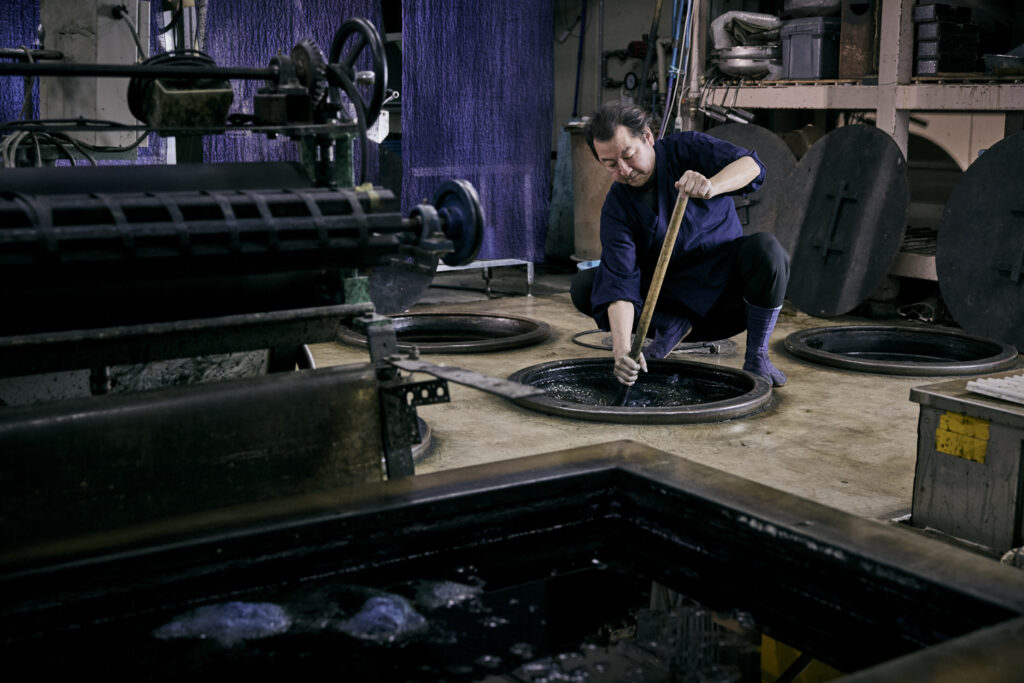
Natural indigo dyer / President, Hon Aizome Masaori Kobo
Hidenori Nakanishi was born in 1966 in Kyoto. In 2022, he won the Kyoto Governor’s Prize at the 41st Kyoto Crafts Artists Association Exhibition for his indigo-dyed kimono, “Eien no Shine.
Index
- Unwavering belief of an indigo dyer in preserving the traditional technique of indigo dyeing, which is attracting worldwide attention.
- 180-degree turnaround from robot manufacturing to indigo dyeing
- Traditional technique, natural lye-fermented Ken- indigo dyeing process
- Hidenori Nakanishi’s Three Creeds
Unwavering belief of an indigo dyer in preserving the traditional technique of indigo dyeing, which is attracting worldwide attention.
Indigo has been used since ancient times as a detoxifying and anti-inflammatory drug. Since the Kamakura period (1185-1333), it has been used by warriors, and in the Edo period (1603-1867), when cotton became widespread, it was widely used for stray clothes, fire coats, curtains, cushions, and so on.
Although indigo dyeing exists in many parts of the world, including indigo blue, which originated in India, Japanese indigo dyeing uses a unique fermentation technique that gives it a distinctive look, so much so that an English chemist who came to Japan in the early Meiji period praised it as “Japan blue. The use of indigo as the emblem for the Tokyo Olympics and Paralympics is also fresh in our minds.

The beautiful colors, excellent efficacy, and eco-friendliness of using only natural ingredients are now being reevaluated, and Japanese indigo dyeing has been attracting attention not only from within Japan but also from around the world in recent years.
However, many of the products currently on the market are cheaply and easily made using synthetic dyes or chemicals in the dyeing process. Hidenori Nakanishi, a natural indigo dyer and representative director of Hon Aizome Gaori Kobo, is concerned about this situation and is striving to preserve natural raw materials and traditional dyeing techniques to pass on the true Japan blue to future generations.
The raw materials and techniques of indigo dyeing are fundamentally different from those of other countries. I believe it is my mission to pass on the uniquely Japanese indigo dyeing to the next generation. I believe this is my mission.
The type of indigo used differs depending on the country or region, such as the Fabaceae family in India and the Brassicaceae family in France, but in Japan, Tate indigo from the Tataceae family is used. Until the Warring States period, the “precipitation method” was the main method of extracting the pigment, but this method was difficult because it could only be used during the hot summer months.
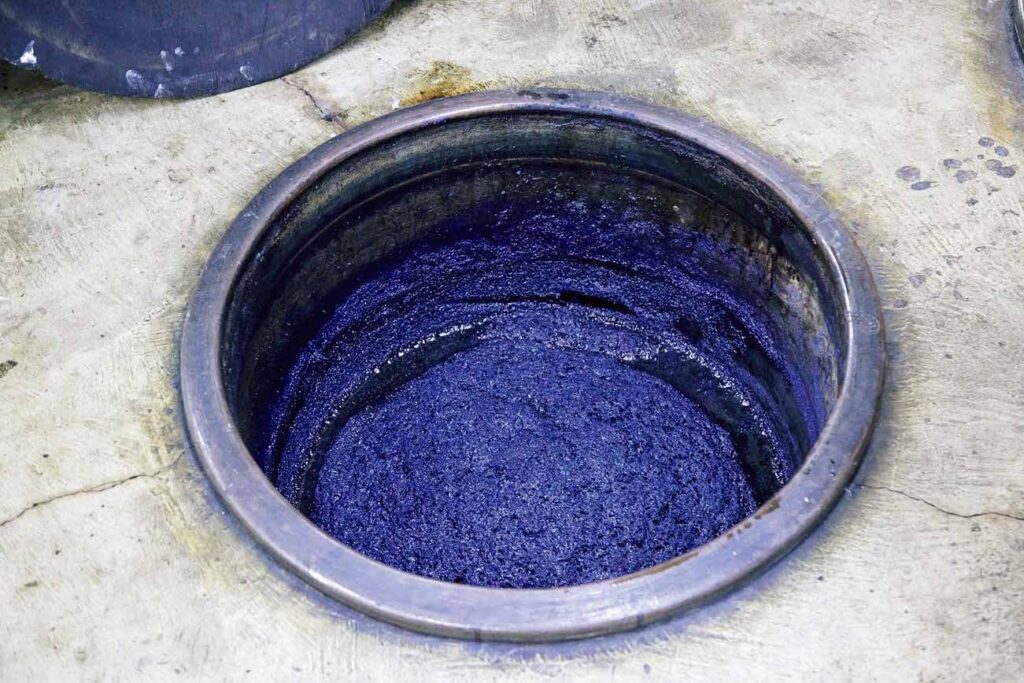
However, a method was devised to ferment indigo leaves for 100 days to produce a dye called sukumo, making it possible to dye with indigo year-round. The technique of “natural lye-fermentation and dye dyeing,” in which the “sukumo” is fermented with lye, lime, and sake, and dyed with a solution of potato and fu (bran [wheat chaff]), was also established. It spread during the Edo period (1603-1867) and became Japan’s traditional indigo dyeing technique.
The indigo we use comes from the Sato family (Sato Awa Ai Seizosho), makers of sukumo, which has been passed down from generation to generation in Tokushima Prefecture. Tate indigo is an annual herb, and seeds are sown and planted every year. After harvesting, only the leaves, the source of the dye, are dried in the sun, but whereas most indigo dyers today use fire, the Sato family only dries the leaves in the sun, as in the past. The Sato family only dries indigo in the sun as in the past. They grow a variety called Shirobana Kojoko, which has been cultivated in Kyoto since the Heian period (794-1185), and it is the only one in Japan that produces indigo. Without the Sato family’s sukumo, traditional indigo dyeing would not be possible.
The widely distributed T. tetani today is the safflower variety, which produces red or pink flowers. On the other hand, the white-flowered variety takes longer to grow, but contains more than twice as much pigment as the safflower variety and has a stronger bluish hue. The variety of indigo colors, known as “48 indigo colors,” can be attributed to the white-flowered koshigamihko.

In fact, in the past, Tapiran was on the verge of extinction. During World War II, the government banned the cultivation of Tapi during the war in order to convert the fields to food cultivation.
The 17th generation of the Sato family, concerned about the crisis of tangerine, continued to cultivate it in secret deep in the mountains with their niece. Of course, this was against government policy, so if the military police had found out, they would have been severely punished. I think they risked their lives to do so.”
The Sato family was also a key player in the indigo-dye tradition.
180-degree turnaround from robot manufacturing to indigo dyeing
Nakanishi decided to become an indigo dyer in 1988, when he was 20 years old and his father, who was running a kimono manufacturing business, started a company specializing in natural lye fermentation and construction indigo dyeing. Nakanishi himself had been involved in robot manufacturing at an electrical equipment manufacturer until then, so it was a complete change of pace for him.
From the cultivation of the tate indigo to the dyeing process, the traditions that our predecessors worked so hard to preserve are alive and well. We cannot let this tradition die out. I have accompanied my father in his work since I was a student, and I knew how wonderful indigo dyeing is, so I had no hesitation.
Two years after jumping in with considerable determination, Nakanishi studied azome production under Akito Sato, the 19th generation of the Sato family, who is the holder of the nationally designated intangible cultural property of Awa Ai production technique. At the same time, he devoted himself to the revival of indigo dyeing of silk yarns after World War II, when the technique was inferior to that of the Edo period.
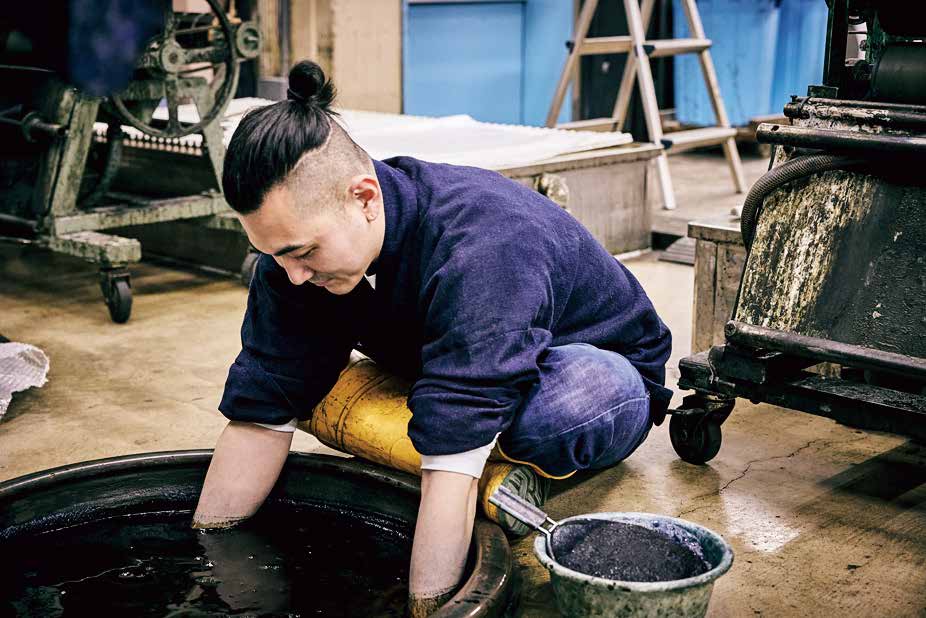
Dyeing delicate silk threads with indigo is difficult. In particular, dyeing silk threads darkly and maintaining the color for a long period of time requires excellent techniques. Therefore, although there were indigo dyers who could handle silk fabrics, the number of craftsmen who could dye silk threads at a high level had already ceased to exist at that time.
I have seen a kosode of Tokugawa Ieyasu made of indigo-dyed silk, and I was very surprised that it is still in wearable condition. I was very surprised to see that it is still in good condition and can be worn today. So I decided to become an indigo dyer who could handle both silk fabrics and threads, and I started my own business when I was 31 years old.
After rigorous training and trial and error, he succeeded in dyeing silk threads to the ideal indigo color. The indigo-dyed kimonos Nakanishi produces are highly acclaimed for their quality, color, and design, and are dedicated to Kiyomizu-dera Temple and other famous shrines and temples in Kyoto, as well as winning the Kyoto Governor’s Prize at the Kyoto Crafts Artists Association Exhibition. However, with the Japanese kimono culture in decline, the company’s management faces challenges such as sales and distribution channels.
We want as many people as possible to know the goodness of indigo dyeing. We also produce masks and towels that take advantage of the antibacterial properties of aizome, as well as stoles and T-shirts that can be used casually and are suited to modern life. We hope that these products will be a gateway for people to eventually pick up indigo-dyed kimonos.
Because of its natural origin, the color of indigo dye changes slightly depending on the indigo crop and the condition of the dye solution on the day of dyeing, and no two indigo dyes are alike. Nakanishi’s pursuit of the ultimate indigo color, and the fact that he is still working with a jar of indigo, is surely the future of Japanese tradition, which we should be proud of, coming to life.
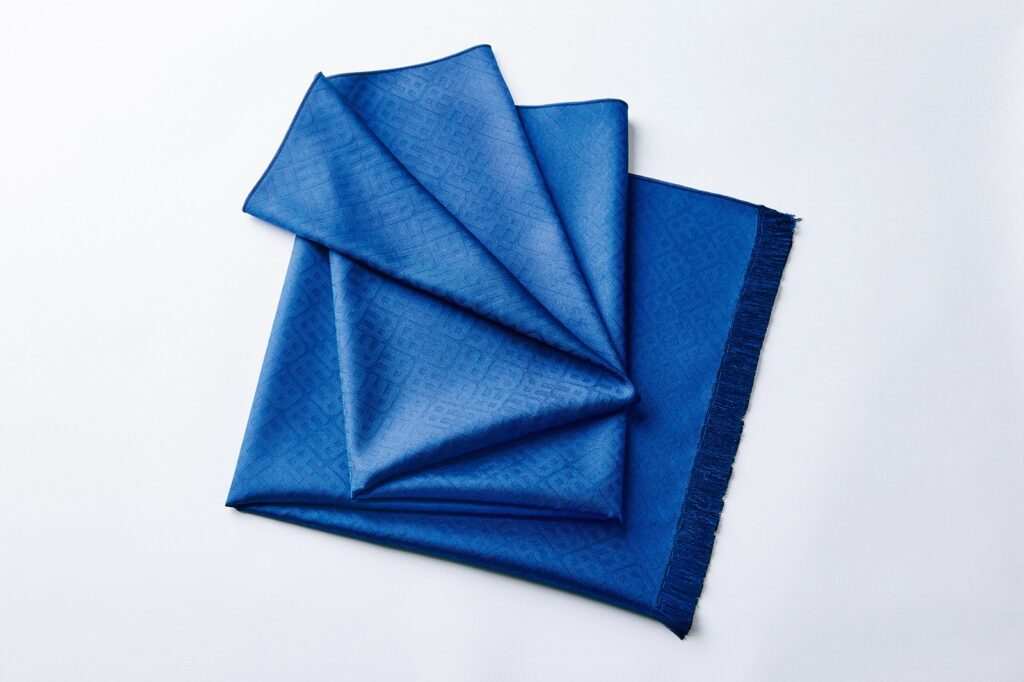

Traditional technique, natural lye-fermented Ken- indigo dyeing process
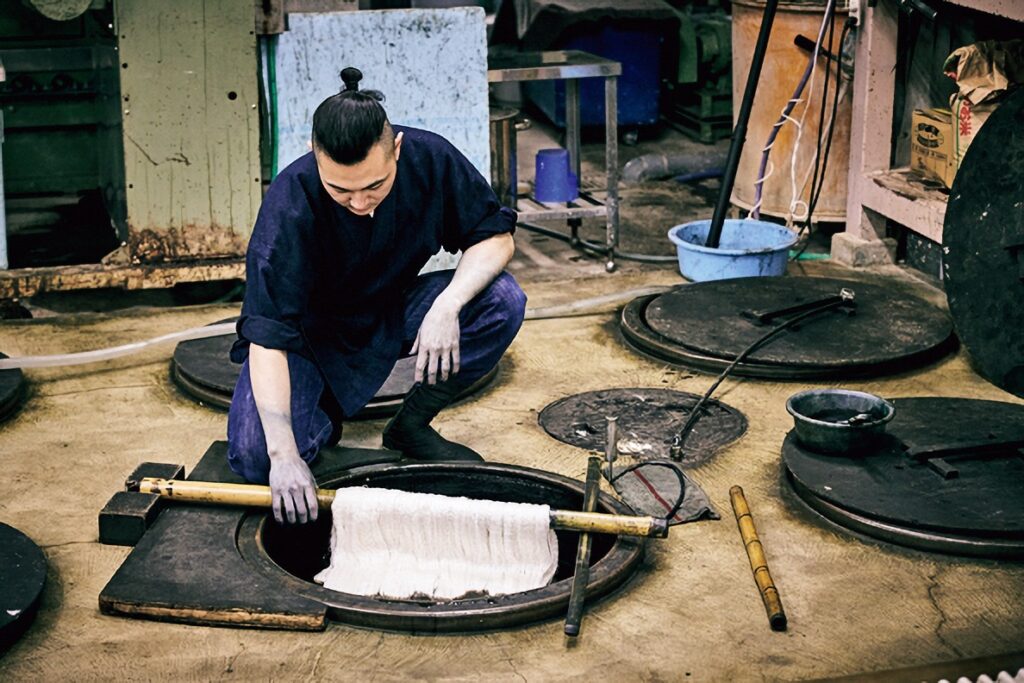
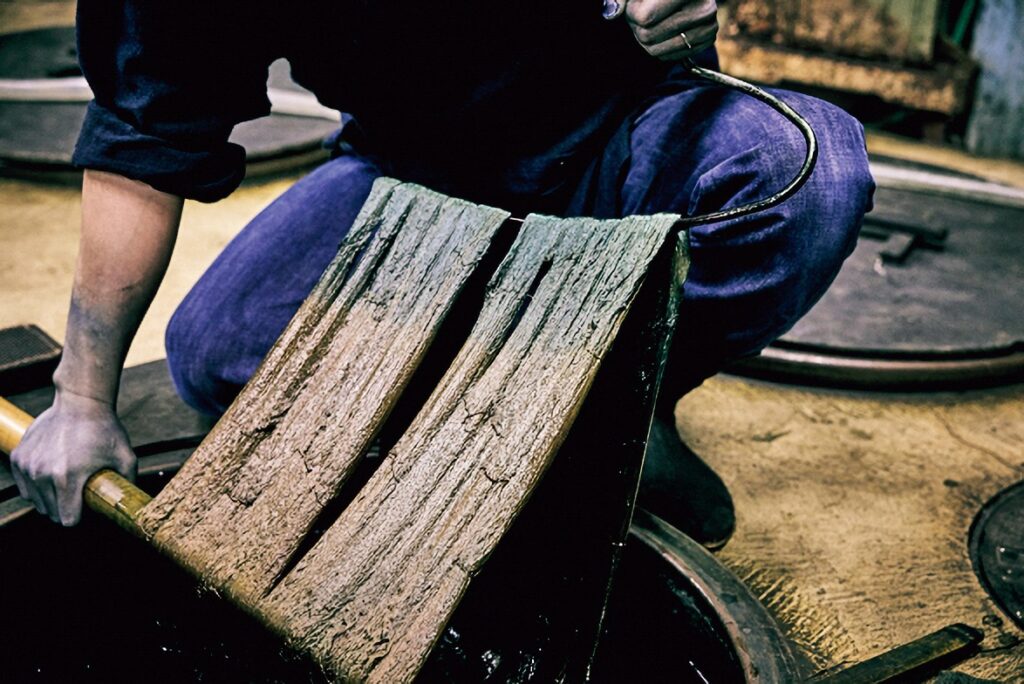
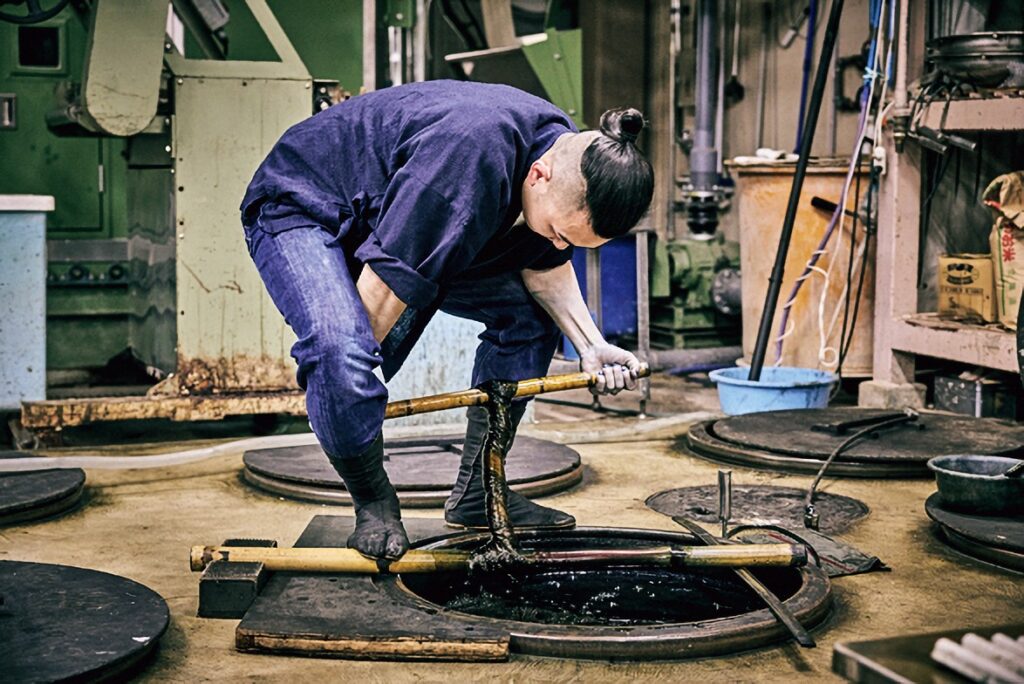
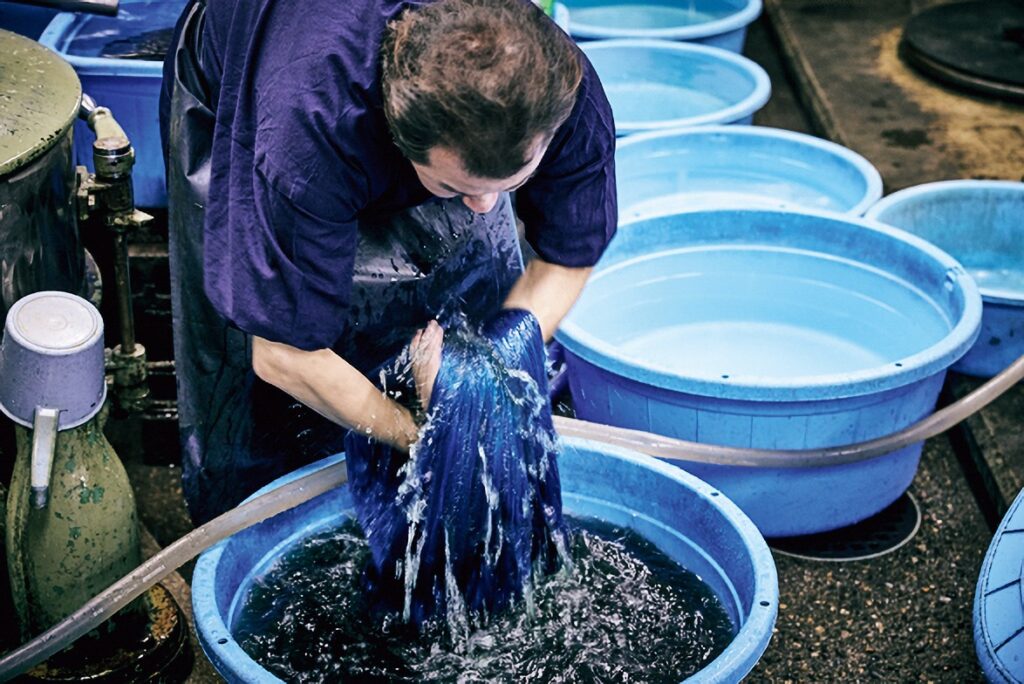
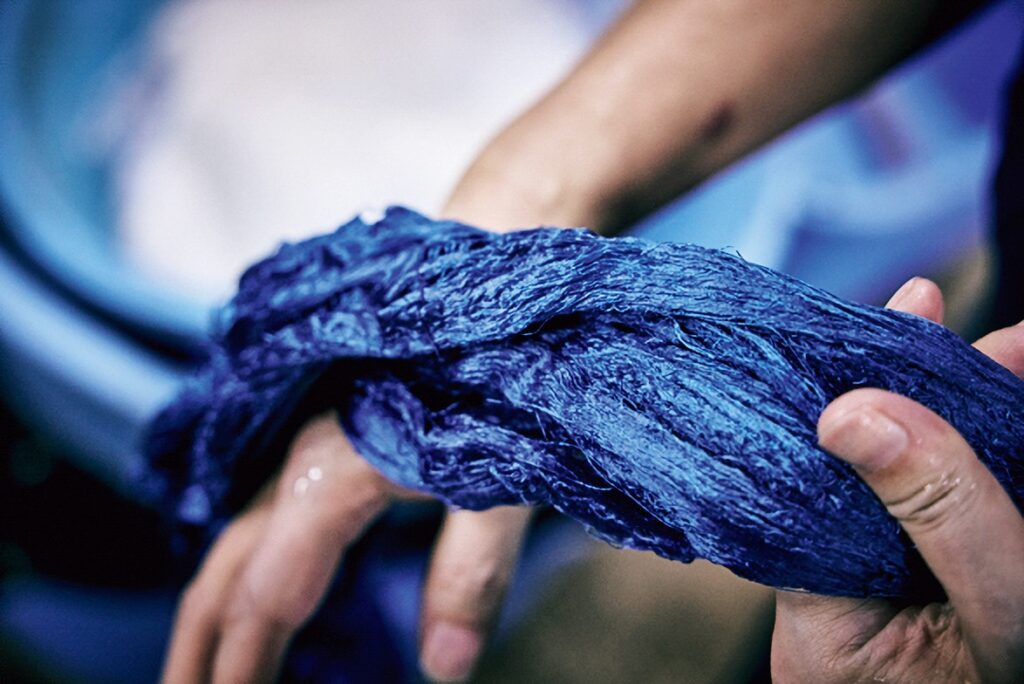
Hidenori Nakanishi’s Three Creeds
1. Lie to those who have gone before us
Most indigo dyers, while claiming to produce indigo dyed goods, add synthetic dyes or use chemicals or reducing solutions in the fermentation of the indigo dye solution. Such techniques cause the colors to fade rapidly, and it is difficult to feel the benefits of the indigo. We will never cut corners and do our work seriously and honestly in order to deliver the true quality of Japanese indigo dyeing,” he said.
2. indigo liquid is a living thing. We interact with it seriously every day.
Natural indigo dye is a living organism that continues to ferment every day. We have to be very serious every day so that we do not misjudge the state of the solution and make mistakes in adding the right ingredients and quantities. Since the intensity of the color of the indigo solution varies depending on the time of production, he adjusts the number of times the solution is soaked in each jar while checking the color. We are never relaxed in order to achieve the ideal color.
3. challenging innovation to connect to the next generation
In order to connect to the next generation, it is essential to be loved by people living in the present. I would like to expand the possibilities of indigo dyeing by actively trying innovative things such as dyeing pearls, crystals, and small leather. He would like to work with any material as long as it is 100% natural and large enough to fit in an indigo jar.
Published in the magazine “GOETHE” June 2024 issue
